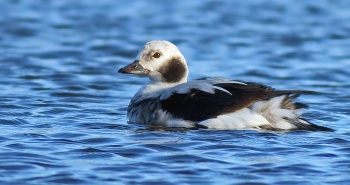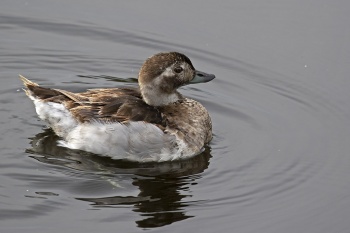- Clangula hyemalis
Identification
Length 39-47 cm (15-18") excluding elongated tail-feathers of male: 10-15cm(4-6")
Wing Span 65-82 cm (26-32")
Complex moult produces at least three different-looking plumage aspects annually. However, assertion that scapulars and feathers on side of head and neck are moulted three times a year now questioned. The three apparent plumage aspects can better be explained by overlapping prebasic and prealternate molts.[4][6] Breast, upper mantle and rest of head and neck are molted twice, and rest of plumage once a year.
Distribution
North America, Europe and Asia.
Arctic in summer; winters down both coasts of North America to mid-latitudes of U.S. Rare occurrences inland and along Gulf Coast, and a single occurrence in the Caribbean.
In Europe in winter along coasts in Western Europe, rarer inland.
In Asia winters along the pacific coast and also inland. Vagrant more south, e.g. Tunisia, India, Jordan or Mexico.
Spring migration through the Baltic is spectacular; main exodus from Gulf of Finland to tundras in NE on late-May evenings with tail-wind, involving over 100,000 birds on peak days.
Taxonomy
This is a monotypic species[1].
Habitat
Breeds commonly in the Arctic on tundra pools and marshes, also along sea coasts (local in the Baltic) and on still-standing mountain waters. Winters at sea.
Behaviour
Gregarious; often in large, dense flocks, mainly off coasts.
Movement
Restless and active, taking off and flying agilely, low over the water, in short pursuit-flights, constantly changing direction, landing with splash.
Diet
Dives for molluscs and other animal food.
Vocalisation
Distinctive male call, variously described as ahr-ahr-ahroulit, ahang-ahóo, ow owooolee, ow ow owoolik, or unk-on-alik. Both sexes give soft gut-gut call while feeding. Long-tailed Duck voice clip
In Culture
Formerly known in North America as the Oldsquaw.
References
- Clements, J. F., T. S. Schulenberg, M. J. Iliff, S. M. Billerman, T. A. Fredericks, B. L. Sullivan, and C. L. Wood. 2019. The eBird/Clements Checklist of Birds of the World: v2019. Downloaded from http://www.birds.cornell.edu/clementschecklist/download/
- BirdLife International. 2018. Clangula hyemalis (amended version of 2017 assessment). The IUCN Red List of Threatened Species 2018: e.T22680427A122303234. Downloaded on 11 September 2018.
- Carboneras, C. & Kirwan, G.M. (2018). Long-tailed Duck (Clangula hyemalis). In: del Hoyo, J., Elliott, A., Sargatal, J., Christie, D.A. & de Juana, E. (eds.). Handbook of the Birds of the World Alive. Lynx Edicions, Barcelona. (retrieved from https://www.hbw.com/node/52919 on 11 September 2018).
- Howell, S. N. G. (2010) Molt in North American Birds. Houghton Mifflin Harcourt, Boston & New York.
- Morlan, J. (2009). What, if anything, is "eclipse" plumage. Birding 41(6):50-52.
- Pyle, P. (2008) Identification Guide to North American Birds - Part II. Slate Creek Press, Point Reyes Station, California.
- Robertson, G. J. and J. L. Savard (2002). Long-tailed Duck (Clangula hyemalis), version 2.0. In The Birds of North America (A. F. Poole and F. B. Gill, Editors). Cornell Lab of Ornithology, Ithaca, NY, USA. https://doi.org/10.2173/bna.651
- Todd, F. S. (1979) Waterfowl - Ducks, Geese & Swans of the World. Harcourt Brace Jovanovich, New York & London.
Recommended Citation
- BirdForum Opus contributors. (2025) Long-tailed Duck. In: BirdForum, the forum for wild birds and birding. Retrieved 25 April 2025 from https://www.birdforum.net/opus/Long-tailed_Duck
External Links
GSearch checked for 2020 platform.








